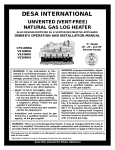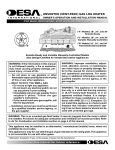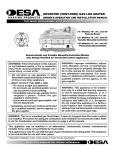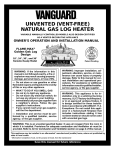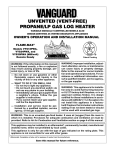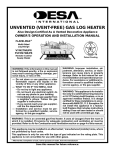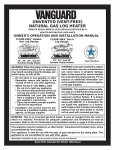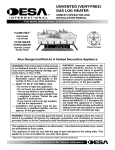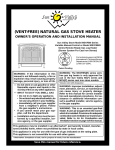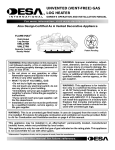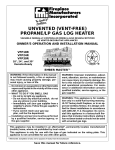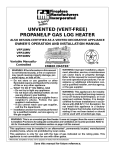Download Desa CFS18PRA User's Manual
Transcript
DESA INTERNATIONAL UNVENTED (VENT-FREE) PROPANE/LP GAS LOG HEATER ALSO DESIGN-CERTIFIED AS A VENTED DECORATIVE APPLIANCE OWNER’S OPERATION AND INSTALLATION MANUAL "A" Model 18", 24", and 30" Remote-Ready CFS18PRA VS18PRA VS24PRA VS30PRA LO ON HI F OF O PIL T REMOTE OFF ® ON WARNING: If the information in this manual is not followed exactly, a fire or explosion may result causing property damage, personal injury, or loss of life. — Do not store or use gasoline or other flammable vapors and liquids in the vicinity of this or any other appliance. — WHAT TO DO IF YOU SMELL GAS • Do not try to light any appliance. • Do not touch any electrical switch; do not use any phone in your building. • Immediately call your gas supplier from a neighbor’s phone. Follow the gas supplier’s instructions. • If you cannot reach your gas supplier, call the fire department. — Installation and service must be performed by a qualified installer, service agency, or the gas supplier. WARNING: Improper installation, adjustment, alteration, service, or maintenance can cause injury or property damage. Refer to this manual for correct installation and operational procedures. For assistance or additional information consult a qualified installer, service agency, or the gas supplier. WARNING: This appliance is for installation only in a solid-fuel burning masonry or UL127 factory-built fireplace, or in an approved ventless firebox. It is designcertified for these installations in accordance with ANS Z21.11.2. Exception: Do not install this appliance in a factory-built fireplace that includes instructions stating it has not been tested or should not be used with unvented gas logs. WARNING: This is an unvented gas-fired heater. It uses air (oxygen) from the room in which it is installed. Provisions for adequate combustion and ventilation air must be provided. Refer to Air for Combustion and Ventilation section on page 4 of this manual. This appliance may be installed in an aftermarket* manufactured (mobile) home, where not prohibited by state or local codes. * Aftermarket: Completion of sale, not for purpose of resale, from the manufacturer Save this manual for future reference. DESA INTERNATIONAL UNVENTED PROPANE/LP GAS LOG HEATER SAFETY INFORMATION WARNINGS IMPORTANT: Read this owner’s manual carefully and completely before trying to assemble, operate, or service this heater. Improper use of this heater can cause serious injury or death from burns, fire, explosion, electrical shock, and carbon monoxide poisoning. DANGER: Carbon monoxide poisoning may lead to death! Carbon Monoxide Poisoning: Early signs of carbon monoxide poisoning resemble the flu, with headaches, dizziness, or nausea. If you have these signs, the heater may not be working properly. Get fresh air at once! Have heater serviced. Some people are more affected by carbon monoxide than others. These include pregnant women, people with heart or lung disease or anemia, those under the influence of alcohol, and those at high altitudes. Propane Gas: Propane gas is odorless. An odor-making agent is added to the gas. The odor helps you detect a gas leak. However, the odor added to the gas can fade. Gas may be present even though no odor exists. Make certain you read and understand all Warnings. Keep this manual for reference. It is your guide to safe and proper operation of this heater. WARNING: Any change to this heater or its controls can be dangerous. 1. 2. 3. This appliance is only for use with the type of gas indicated on the rating plate. This appliance is not convertible for use with other gases. Do not place propane supply tank(s) inside any structure. Locate propane supply tank(s) outdoors. If you smell gas • shut off gas supply • do not try to light any appliance • do not touch any electrical switch; do not use any phone in your building • immediately call your gas supplier from a neighbor’s phone. Follow the gas supplier’s instructions • if you cannot reach your gas supplier, call the fire department 4. This heater shall not be installed in a bedroom or bathroom unless installed as a vented appliance (see Installing Damper Clamp Accessory for Vented Operation, page 10). 5. Never install the heater • in a recreational vehicle • where curtains, furniture, clothing, or other flammable objects are less than 42 inches from the front, top, or sides of the heater • in high traffic areas • in windy or drafty areas 6. Before installing in a solid fuel burning fireplace, the chimney flue and firebox must be cleaned of soot, creosote, ashes and loose paint by a qualified chimney cleaner. Creosote will ignite if highly heated. Inspect chimney flue for damage. If damaged, operate heater with flue damper closed. 7. If fireplace has glass doors, never operate this heater with glass doors closed. If you operate heater with doors closed, heat buildup inside fireplace will cause glass to burst. Also if fireplace opening has vents at the bottom, you must open the vents before operating heater. 8. You must operate this heater with a fireplace screen in place. Make sure fireplace screen is closed before running heater. 9. This log heater is designed to be smokeless. If logs ever appear to smoke, turn off heater and call a qualified service person. Note: During initial operation, slight smoking may occur due to log curing and heater burning manufacturing residues. 10. To prevent the creation of soot, follow the instructions in Cleaning and Maintenance, page 18. 11. Do not allow fans to blow directly into the fireplace. Avoid any drafts that alter burner flame patterns. Ceiling fans may create drafts that alter burner flame patterns. Altered burner patterns can cause sooting. 12. Before using furniture polish, wax, carpet cleaner, or similar products, turn heater off. If heated, the vapors from 2 13. 14. 15. 16. 17. 18. 19. 20. 21. 22. 23. these products may create a white powder residue within burner box or on adjacent walls or furniture. Do not use a blower insert, heat exchanger insert or other accessory not approved for use with this heater. This heater needs fresh, outside air ventilation to run properly. This heater has an oxygen depletion sensor (ODS) pilot light safety system. The ODS shuts down the heater if not enough fresh air is available. See Air for Combustion and Ventilation, pages 4 through 6. If heater keeps shutting off, see Troubleshooting, pages 19 through 21. Do not run heater • where flammable liquids or vapors are used or stored • under dusty conditions Do not use this heater to cook food or burn paper or other objects. Never place any objects on the heater. Heater base assembly becomes very hot when running heater. Keep children and adults away from hot surface to avoid burns or clothing ignition. Heater will remain hot for a time after shutdown. Allow surface to cool before touching. Carefully supervise young children when they are in the room with heater. When using the hand-held remote accessory, keep selector switch in the OFF position to prevent children from turning on burners with hand-held remote control unit. Do not use heater if any part has been exposed to or under water. Immediately call a qualified service technician to inspect the room heater and to replace any part of the control system and any gas control which has been under water. Do not operate heater if any log is broken. Do not operate heater if a log is chipped (dime-sized or larger). Turn heater off and let cool before servicing, installing, or repairing. When using the hand-held remote accessory, make sure the selector switch is in the OFF position. Only a qualified service person should install, service, or repair heater. When using the hand-held remote accessory, make sure the selector switch is in the OFF position when you are away from home for long periods of time. 104417 OWNER’S MANUAL SAFETY INFORMATION PRODUCT IDENTIFICATION Crossover Log Continued 24. This heater must not be connected to any external electrical source. 25. Operating heater above elevations of 4,500 feet may cause pilot outage. 26. To prevent performance problems, the use of a propane fuel tank of less than 100 lb. capacity is not recommended. UNPACKING WARNING: Do not remove the metal data plates attached to the heater base assembly. The data plates contain important warranty information. 1. 2. 3. Remove logs and heater base assembly from carton. Note: Do not pick up heater base assembly by burners. This could damage heater. Always handle base assembly by grate. Remove all protective packaging applied to logs and heater for shipment. Check all items for any shipping damage. If damaged, promptly inform dealer where you bought heater. LOCAL CODES Install and use heater with care. Follow all local codes. In the absence of local codes, use the latest edition of The National Fuel Gas Code ANS Z223.1, also known as NFPA 54*. *Available from: American National Standards Institute, Inc. Batterymarch Park New York, NY 10018 National Fire Protection Association, Inc. 1430 Broadway Quincy, MA 02269 Note: Where listed vented decorative logs are required, thermostat operation is not permitted. 104417 Rear Log Front Branch Rear Burner Front Burner Piezo Ignitor HI TE MA MP N LO AU TO ON OF F ST AT US Control Knob Remote Control (Optional) Flame Adjustment Knob Selector Switch (Optional) Middle Log Base Assembly Figure 1 - VS24PR Shown PRODUCT FEATURES OPERATION PIEZO IGNITION SYSTEM This heater has a piezo ignitor. This system requires no matches, batteries, or other sources to light heater. This heater is clean burning. It requires no outside venting. There is no heat loss out a vent or up a chimney. Heat is generated by both realistic flames and glowing coals. This heater is designed for vent-free operation with flue damper closed. It has been tested and approved to ANS Z21.11.2 standard for unvented heaters. State and local codes in some areas prohibit the use of ventfree heaters. This heater may also be operated as a vented decorative (ANS Z21.60) product by opening the flue damper (nonthermostat operation only). OPTIONAL REMOTE CONTROL ACCESSORIES SAFETY PILOT See Accessories, page 25. This heater has a pilot with an Oxygen Depletion Sensor Shutoff System (ODS). The ODS/pilot is a required feature for ventfree room heaters. The ODS/pilot shuts off the heater if there is not enough fresh air. The wall thermostat or hand-held thermostat may not be used where vented decorative listing is required. 3 There are four optional remote controls that can be purchased separately for this log heater: • wall switch • wall thermostat • hand-held on/off remote • hand-held thermostat remote. DESA INTERNATIONAL UNVENTED PROPANE/LP GAS LOG HEATER AIR FOR COMBUSTION AND VENTILATION WARNING: This heater shall not be installed in a confined space or unusually tight construction unless provisions are provided for adequate combustion and ventilation air. Read the following instructions to insure proper fresh air for this and other fuel-burning appliances in your home. Today’s homes are built more energy efficient than ever. New materials, increased insulation, and new construction methods help reduce heat loss in homes. Home owners weather strip and caulk around windows and doors to keep the cold air out and the warm air in. During heating months, home owners want their homes as airtight as possible. While it is good to make your home energy efficient, your home needs to breathe. Fresh air must enter your home. All fuel-burning appliances need fresh air for proper combustion and ventilation. Exhaust fans, fireplaces, clothes dryers, and fuel burning appliances draw air from the house to operate. You must provide adequate fresh air for these appliances. This will insure proper venting of vented fuelburning appliances. PROVIDING ADEQUATE VENTILATION The following are excerpts from National Fuel Gas Code. NFPA 54/ANS Z223.1, Section 5.3, Air for Combustion and Ventilation. All spaces in homes fall into one of the three following ventilation classifications: 1. Unusually Tight Construction 2. Unconfined Space 3. Confined Space The information on pages 4 through 6 will help you classify your space and provide adequate ventilation. Unusually Tight Construction The air that leaks around doors and windows may provide enough fresh air for combustion and ventilation. However, in buildings of unusually tight construction, you must provide additional fresh air. Unusually tight construction is defined as construction where: a. walls and ceilings exposed to the outside atmosphere have a continuous water vapor retarder with a rating of one perm (6 x 10-11 kg per pa-sec-m2) or less with openings gasketed or sealed and b. weather stripping has been added on openable windows and doors and c. caulking or sealants are applied to areas such as joints around window and door frames, between sole plates and floors, between wall-ceiling joints, between wall panels, at penetrations for plumbing, electrical, and gas lines, and at other openings. Confined and Unconfined Space The National Fuel Gas Code (ANS Z223.1, 1992 Section 5.3) defines a confined space as a space whose volume is less than 50 cubic feet per 1,000 Btu per hour (4.8 m3 per kw) of the aggregate input rating of all appliances installed in that space and an unconfined space as a space whose volume is not less than 50 cubic feet per 1,000 Btu per hour (4.8 m3 per kw) of the aggregate input rating of all appliances installed in that space. Rooms communicating directly with the space in which the appliances are installed*, through openings not furnished with doors, are considered a part of the unconfined space. This heater shall not be installed in a confined space or unusually tight construction unless provisions are provided for adequate combustion and ventilation air. * Adjoining rooms are communicating only if there are doorless passageways or ventilation grills between them. If your home meets all of the three criteria above, you must provide additional fresh air. See Ventilation Air From Outdoors, page 6. If your home does not meet all of the three criteria above, proceed to Determining Fresh-Air Flow for Heater Location, page 5. 4 104417 OWNER’S MANUAL AIR FOR COMBUSTION AND VENTILATION Continued DETERMINING FRESH-AIR FLOW FOR HEATER LOCATION Determining if You Have a Confined or Unconfined Space Use this work sheet to determine if you have a confined or unconfined space. Space: Includes the room in which you will install heater plus any adjoining rooms with doorless passageways or ventilation grills between the rooms. 1. Determine the volume of the space (length x width x height). Length x Width x Height = _________________ cu. ft. (volume of space) Example: Space size 20 ft. (length) x 16 ft. (width) x 8 ft. (ceiling height) = 2560 cu. ft. (volume of space) If additional ventilation to adjoining room is supplied with grills or openings, add the volume of these rooms to the total volume of the space. 2. Divide the space volume by 50 cubic feet to determine the maximum Btu/Hr the space can support. _________________ (volume of space) ÷ 50 cu. ft. = (Maximum Btu/Hr the space can support) Example: 2560 cu. ft. (volume of space) ÷ 50 cu. ft. = 51.2 or 51,200 (maximum Btu/Hr the space can support) 3. Add the Btu/Hr of all fuel burning appliances in the space. Vent-free heater ______________ Btu/Hr Gas water heater* ______________ Btu/Hr Example: Gas furnace ______________ Btu/Hr Gas water heater 40,000 Btu/Hr Vented gas heater ______________ Btu/Hr Vent-free heater + 33,000 Btu/Hr Gas fireplace logs ______________ Btu/Hr Total = 73,000 Btu/Hr Other gas appliances* + ______________ Btu/Hr Total = ______________ Btu/Hr * Do not include direct-vent gas appliances. Direct-vent draws combustion air from the outdoors and vents to the outdoors. 4. Compare the maximum Btu/Hr the space can support with the actual amount of Btu/Hr used. _________________ Btu/Hr (maximum the space can support) _________________ Btu/Hr (actual amount of Btu/Hr used) Example: 51,200 Btu/Hr (maximum the space can support) 73,000 Btu/Hr (actual amount of Btu/Hr used) The space in the above example is a confined space because the actual Btu/Hr used is more than the maximum Btu/Hr the space can support. You must provide additional fresh air. Your options are as follows: A. Rework worksheet, adding the space of an adjoining room. If the extra space provides an unconfined space, remove door to adjoining room or add ventilation grills between rooms. See Ventilation Air From Inside Building, page 6. B. Vent room directly to the outdoors. See Ventilation Air From Outdoors, page 6. C. Install a lower Btu/Hr heater, if lower Btu/Hr size makes room unconfined. If the actual Btu/Hr used is less than the maximum Btu/Hr the space can support, the space is an unconfined space. You will need no additional fresh air ventilation. WARNING: If the area in which the heater may be operated is smaller than that defined as an unconfined space or if the building is of unusually tight construction, provide adequate combustion and ventilation air by one of the methods described in the National Fuel Gas Code, ANS Z223.1, 1992, Section 5.3 or applicable local codes.. Continued 104417 5 DESA INTERNATIONAL UNVENTED PROPANE/LP GAS LOG HEATER AIR FOR COMBUSTION AND VENTILATION Continued VENTILATION AIR 12" Ventilation Grills Into Adjoining Room, Option 1 Ventilation Air From Inside Building This fresh air would come from an adjoining unconfined space. When ventilating to an adjoining unconfined space, you must provide two permanent openings: one within 12" of the ceiling and one within 12" of the floor on the wall connecting the two spaces (see options 1 and 2, Figure 2). You can also remove door into adjoining room (see option 3, Figure 2). Follow the National Fuel Gas Code NFPA 54/ANS Z223.1, Section 5.3, Air for Combustion and Ventilation for required size of ventilation grills or ducts. WARNING: Rework worksheet, adding the space of the adjoining unconfined space. The combined spaces must have enough fresh air to supply all appliances in both spaces. Ventilation Grills Into Adjoining Room, Option 2 Or Remove Door into Adjoining Room, Option 3 12" Figure 2 - Ventilation Air from Inside Building Outlet Air Ventilated Attic Outlet Air To Attic Ventilation Air From Outdoors Provide extra fresh air by using ventilation grills or ducts. You must provide two permanent openings: one within 12" of the ceiling and one within 12" of the floor. Connect these items directly to the outdoors or spaces open to the outdoors. These spaces include attics and crawl spaces. IMPORTANT: Do not provide openings for inlet or outlet air into attic if attic has a thermostat-controlled power vent. Heated air entering the attic will activate the power vent. To Crawl Space Inlet Air Inlet Air Ventilated Crawl Space Figure 3 - Ventilation Air from Outdoors 6 104417 OWNER’S MANUAL INSTALLATION NOTICE: This heater is intended for use as supplemental heat. Use this heater along with your primary heating system. Do not install this heater as your primary heat source. If you have a central heating system, you may run system’s circulating blower while using heater. This will help circulate the heat throughout the house. In the event of a power outage, you can use this heater as your primary heat source. NOTICE: A qualified service person must install heater. Follow all local codes. NOTICE: State or local codes may only allow operation of this appliance in a vented configuration. Check your state or local codes. WARNING: Make sure the selector switch is in the OFF position before installing heater. WARNING: Before installing in a solid fuel burning fireplace, the chimney flue and firebox must be cleaned of soot, creosote, ashes and loose paint by a qualified chimney cleaner. Creosote will ignite if highly heated. A dirty chimney may create and distribute soot within the house. Inspect chimney flue for damage. If damaged, operate heater with flue damper closed. WARNING: Never install the heater • in a bedroom or bathroom unless installed as a vented appliance, see page 10. • in a recreational vehicle • where curtains, furniture, clothing, or other flammable objects are less than 42 inches from the front, top, or sides of the heater • in high traffic areas • in windy or drafty areas INSTALLATION AND CLEARANCES (Vent-Free Operation Only) WARNING: Maintain the minimum clearances. If you can, provide greater clearances from floor, ceiling, and adjoining wall. MINIMUM FIREPLACE CLEARANCE TO COMBUSTIBLE MATERIALS Log Size Side Wall Ceiling Floor* 18" 24" 30" CAUTION: This heater creates warm air currents. These currents move heat to wall surfaces next to heater. Installing heater next to vinyl or cloth wall coverings or operating heater where impurities (such as tobacco smoke, aromatic candles, cleaning fluids, oil or kerosene lamps, etc.) in the air exist, may discolor walls. IMPORTANT: Vent-free heaters add moisture to the air. Although this is beneficial, installing heater in rooms without enough ventilation air may cause mildew to form from too much moisture. See Air for Combustion and Ventilation, pages 4 through 6. CHECK GAS TYPE Use only propane gas. If your gas supply is not propane gas, do not install heater. Call dealer where you bought heater for proper type heater. 16" 42" 5" *See Floor Clearances, page 9. LOG SIZING REQUIREMENTS Minimum Firebox Size Log Front Rear* Size Height Depth Width Width 18" 24" 30" 17" 17" 17" 14" 14" 14" 20" 26" 32" 14" 18" 22" *Measured at 14" depth Carefully follow the instructions below. This will ensure safe installation into a masonry, UL127-listed manufactured fireplace, or listed vent-free firebox. Minimum Wall and Ceiling Clearances (see Figure 4) A. Clearances from the side of the fireplace opening to any combustible wall should not be less than 16 inches. B. Clearances from the top of the fireplace opening to the ceiling should not be less than 42 inches. 42" WARNING: Seal any fresh air vents or ash clean-out doors located on floor or wall of fireplace. If not, drafting may cause pilot outage or sooting. Use a heatresistant sealant. Do not seal chimney flue damper. 16" Left and Right Sides Figure 4 - Minimum Clearance to Wall and Ceiling Continued 104417 7 DESA INTERNATIONAL UNVENTED PROPANE/LP GAS LOG HEATER INSTALLATION If Using Mantel Continued You must have noncombustible material(s) above the fireplace opening. Noncombustible materials (such as slate, marble, tile, etc.) must be at least 1/2 inch thick. With sheet metal, you must have noncombustible material behind it. Noncombustible material must extend at least 8 inches up (for all models). If noncombustible material is less than 12", you must install the fireplace hood accessory (24" and 30" models only). Even if noncombustible material is more than 12", you may need the hood accessory to deflect heat away from your mantel shelf. See Figure 5 and Figures 6 and 7, page 9, for minimum clearances. NOTICE: Manual control heaters may be used as a vented product. If so, you must always run heater with chimney flue damper open. If running heater with damper open, noncombustible material above fireplace opening is not needed. Go to Installing Damper Clamp Accessory for Vented Operation, page 10). Minimum Noncombustible Material Clearances If Not Using Mantel Note: If using a mantel, proceed to If Using Mantel. If not using a mantel, follow the information below. You must have noncombustible material(s) above the fireplace opening. Noncombustible materials (such as slate, marble, tile, etc.) must be at least 1/2 inch thick. With sheet metal, you must have noncombustible material behind it. If noncombustible material is less than 12", you must install the fireplace hood accessory (24" and 30" models only). See Figure 5 for minimum clearances. IMPORTANT: If you cannot meet these minimum clearances, you must operate heater with chimney flue damper open. Go to Installing Damper Clamp Accessory for Vented Operation, page 10. Noncombustible Material Distance (A) Requirements for Safe Installation 12" or more Noncombustible material OK. Between 8" and 12" Install fireplace hood accessory (GA6050, GA6052, or GA6053 see Accessories, page 25). Less than 8" Noncombustible material must be extended to at least 8". See Between 8" and 12", above. Heat Resistant Material (A) IMPORTANT: If you cannot meet these minimum clearances, you must operate heater with chimney flue damper open. Go to Installing Damper Clamp Accessory for Vented Operation, page 10. Figure 5 - Heat Resistant Material (Slate, Marble, Tile, etc.) Above Fireplace 8 104417 OWNER’S MANUAL INSTALLATION Mantel Shelf 10" Continued MANTEL CLEARANCES In addition to meeting noncombustible material clearances, you must also meet required clearances between fireplace opening and mantel shelf. If you do not meet clearances listed in Figure 6 you will need a hood. Determining Minimum Mantel Clearance 6" 2 1/2" All minimum distances are in inches Minimum NonCombustible Material (A) If you meet minimum clearance between mantel shelf and top of fireplace opening, a hood is not required (see Figure 6). 12" 18" 20" 22" 24" Log Set 24"/30" Models 8" 14" 16 3/4" 18 1/2" 20" 18" Model Top of Fireplace Opening Minimum NonCombustible Material Height Determining Minimum Mantel Clearance When Using a Hood If minimum clearances in Figure 6 are not met, you must have a hood. When using a hood there are still certain minimum mantel clearances required. Follow minimum clearances shown in Figure 7 when using hood. Underside of Mantel Shelf 8" Distances to Underside of Mantel Figure 6 - Minimum Mantel Clearances Without Using Hood Mantel Shelf 12" Underside of Mantel Shelf 10" NOTICE: If your installation does not meet the minimum clearances shown, you must do one of the following: • operate the logs only with the flue damper open • raise the mantel to an acceptable height • remove the mantel 8" 6" 2 1/2" Minimum NonCombustible Material Log Sets 8" Min. 12" Hood Hood (GA6050, GA6052, GA6052) (GA6050, or GA6053) 18" 20" 18", 24", & 30" Models Distances to Underside of Mantel Figure 7 - Minimum Mantel Clearances When Using Hood 14" Min. Combustible Material Hearth Hearth Noncombustible Material Figure 8 - Minimum Fireplace Clearances If Installed at Floor Level 104417 15" Top of Fireplace Opening FLOOR CLEARANCES A. If installing appliance on the floor level, you must maintain the minimum distance of 14" to combustibles (see Figure 8). B. If combustible materials are less than 14" to the fireplace, you must install appliance at least 5" above the combustible flooring (see Figure 9). All minimum distances are in inches 9 Combustible Combustible Material Material 5" 5" Min. Min. Figure 9 - Minimum Fireplace Clearances Above Combustible Flooring Continued DESA INTERNATIONAL UNVENTED PROPANE/LP GAS LOG HEATER Damper Clamp INSTALLATION Continued INSTALLING DAMPER CLAMP ACCESSORY FOR VENTED OPERATION Damper Damper Note: When used as a vented heater, appliance must be installed only in a solid-fuel burning fireplace with a working flue and constructed of noncombustible material. If your heater is a manually controlled model, you may use this heater as a vented product. There are three reasons for operating your heater in the vented mode. 1. The fireplace does not meet the clearance to combustibles requirements for vent-free operation. 2. State or local codes do not permit ventfree operation. 3. You prefer vented operation. If reasons number 1 or 2 above apply to you, you must permanently open chimney flue damper. You must install the damper clamp accessory (to order, see Accessories, page 25). This will insure vented operation (see Figure 10). The damper clamp will keep damper open. Installation instructions are included with clamp accessory. See chart below for minimum permanent flue opening you must provide. Attach damper clamp so the minimum permanent flue opening will be maintained at all times. Area of Various Standard Round Flues Diameter (ins.) 5" 6" 7" 8" Area (sq. ins.) 20 sq. inches 29 sq. inches 39 sq. inches 51 sq. inches Chimney Minimum Permanent Height (ft.) Flue Opening (sq. ins.) 6' to 15' 39 sq. inches 15' to 30' 2.9 sq. inches Damper Clamp Damper Manufactured Fireplace Masonry Fireplace Figure 10 - Attaching Damper Clamp INSTALLING HEATER BASE ASSEMBLY WARNING: Do not remove the metal data plates attached to the heater base assembly. The data plates contain important warranty information. WARNING: You must secure this heater to fireplace floor. If not, heater will move when you adjust controls. Moving heater may cause a gas leak. WARNING: If installing in a sunken fireplace, special care is needed. You must raise the fireplace floor to allow access to heater control panel. This will insure adequate air flow and guard against sooting. Raise fireplace floor with noncombustible material. Make sure material is secure. CAUTION: Do not pick up heater base assembly by burners. This could damage heater. Only handle base assembly by grates. Installation Items Needed • hardware package (provided with heater) • approved flexible gas hose (not provided) (if allowed by local codes) • sealant (resistant to propane/LP gas, not provided) • electric drill with 3/16" drill bit Note: Install optional GHRCT Receiver and Hand-Held Remote Control Kit (see Accessories, page 25) before installing gas log heater. See installation instructions included with the kit. 1. Apply pipe joint sealant lightly to male threads of gas fitting. Connect approved flexible gas hose to inlet side of gas control (see Figure 11, page 11). 2. Position heater base assembly in fireplace. 3. Mark screw locations through holes in front panel of base (see Figure 12, page 11). If installing in a brick-bottom fireplace, mark screw locations in mortar joint of bricks. 4. Remove heater base from fireplace. 5. Drill holes at marked locations using 3/16" masonry drill bit. 6. Attach base to fireplace floor using masonry screws (in hardware package). 7. Connect to gas supply. See Connecting To Gas Supply, page 11. IMPORTANT: Make sure the heater burners are level. If heater is not level, heater will not work properly. 10 104417 OWNER’S MANUAL INSTALLATION Continued Gas Control Flexible Gas Hose (if allowed by local codes) Figure 11 - Attaching Flexible Gas Hose to Heater Gas Regulator • • • • • • sealant (resistant to propane/LP gas) manual shutoff valve * test gauge connection * sediment trap tee joint pipe wrench * An A.G.A. design-certified manual shutoff valve with 1/8" NPT tap is an acceptable alternative to test gauge connection. Purchase the optional A.G.A. design-certified manual shutoff valve from your dealer. See Accessories, page 25. Propane Supply Tank Masonry Screw WARNING: Never connect heater to private (non-utility) gas wells. This gas is commonly known as wellhead gas. Masonry Screw External Regulator Vent Pointing Down Figure 13 - External Regulator With Vent Pointing Down Figure 12 - Attaching Base to Fireplace Floor CONNECTING TO GAS SUPPLY NOTICE: A qualified service person must connect heater to gas supply. Follow all local codes. Installation Items Needed Before installing heater, make sure you have the items listed below. • external regulator (supplied by installer, see Figure 13) • piping (check local codes) CAUTION: Use only new, black iron or steel pipe. Internally-tinned copper tubing may be used in certain areas. Check your local codes. Use pipe of 1/2" diameter or greater to allow proper gas volume to heater. If pipe is too small, undue loss of pressure will occur. Installation must include a manual shutoff valve, union, and plugged 1/8" NPT tap. Locate NPT tap within reach for test gauge hook up. NPT tap must be upstream from heater (see Figure 14). A.G.A. Design-Certified Manual Shutoff Valve With 1/8" NPT Tap* Approved Flexible Gas Hose (if allowed by local codes) From External Regulator (11" W.C.** to 14" W.C. Pressure) Gas Control CAUTION: Never connect heater directly to the propane supply. This heater requires an external regulator (not supplied). Install the external regulator between the heater and propane supply. 104417 The installer must supply an external regulator. The external regulator will reduce incoming gas pressure. You must reduce incoming gas pressure to between 11 and 14 inches of water. If you do not reduce incoming gas pressure, heater regulator damage could occur. Install external regulator with the vent pointing down as shown in Figure 13. Pointing the vent down protects it from freezing rain or sleet. 3" Minimum Tee Joint Pipe Nipple Cap Sediment Trap * Purchase the optional A.G.A. design-certified manual shutoff valve from your dealer. See Accessories, page 25. ** Minimum inlet pressure for purpose of input adjustment. Figure 14 - Gas Connection Continued 11 DESA INTERNATIONAL UNVENTED PROPANE/LP GAS LOG HEATER INSTALLATION Continued Apply pipe joint sealant lightly to male threads. This will prevent excess sealant from going into pipe. Excess sealant in pipe could result in clogged heater valves. CAUTION: Use pipe joint sealant that is resistant to liquid petroleum (LP) gas. Install sediment trap in supply line as shown in Figure 14, page 11. Locate sediment trap where it is within reach for cleaning. Locate sediment trap where trapped matter is not likely to freeze. A sediment trap traps moisture and contaminants. This keeps them from going into heater controls. If sediment trap is not installed or is installed wrong, heater may not run properly. CAUTION: Avoid damage to gas control. Hold gas control with wrench when connecting it to gas piping and/or fittings. CHECKING GAS CONNECTIONS WARNING: Test all gas piping and connections for leaks after installing or servicing. Correct all leaks at once. WARNING: Never use an open flame to check for a leak. Apply a mixture of liquid soap and water to all joints. Bubbles forming show a leak. Correct all leaks at once. Pressure Testing gas Supply Piping system Pressure Testing Heater Gas Connections Test Pressures In Excess Of 1/2 PSIG 1. Disconnect heater and its individual manual shutoff valve from gas supply piping system. Pressures in excess of 1/2 psig will damage heater regulator. 2. Cap off open end of gas pipe where manual shutoff valve was connected. 3. Pressurize supply piping system by either using compressed air or opening propane supply tank valve. 4. Check all joints of gas supply piping system. Apply mixture of liquid soap and water to gas joints. Bubbles forming show a leak. 5. Correct all leaks at once. 6. Reconnect heater and manual shutoff valve to gas supply. Check reconnected fittings for leaks. 1. Test Pressures Equal To or Less Than 1/2 PSIG 1. Close manual shutoff valve (see Figure 15). 2. Pressurize supply piping system by either using compressed air or opening propane supply tank valve. 3. Check all joints from propane supply tank to manual shutoff valve (see Figure 16). Apply mixture of liquid soap and water to gas joints. Bubbles forming show a leak. 4. Correct all leaks at once. 2. 3. 4. 5. 6. 7. Open manual shutoff valve (see Figure 15). Open propane supply tank valve. Make sure control knob of heater is in the OFF position. Check all joints from manual shutoff valve to gas control (see Figure 16). Apply mixture of liquid soap and water to gas joints. Bubbles forming show a leak. Correct all leaks at once. Light heater (see Operating Heater, pages 14 through 16). Check all other internal joints for leaks. Turn off heater (see To Turn Off Gas to Appliance, page 15). Propane Supply Tank Manual Shutoff Valve Control Valve Location Figure 16 - Checking Gas Joints Open ON POSITI Manual Shutoff Valve O POSI Closed CAUTION: Make sure external regulator has been installed between propane supply and heater. See guidelines under Connecting to Gas Supply, page 11. Figure 15 - Manual Shutoff Valve 12 104417 OWNER’S MANUAL Peg INSTALLATION Front Log (#1) Continued INSTALLING LOGS WARNING: Failure to position the parts in accordance with these diagrams or failure to use only parts specifically approved with this heater may result in property damage or personal injury. Each log is marked with a number. These numbers will help you identify the log when installing. It is very important to install these logs exactly as instructed. Do not modify logs. Only use logs supplied with heater. 1. Place front log (#1) on top of the grate. Make sure the notches in the bottom of the log fits over the grate prongs (see Figure 17). Push back of log flush with metal grate bar. 2. Rest middle log (#2) behind metal posts on front burner. Make sure the grooves in the bottom of the log fit over the grate. Bring the log forward next to the metal posts. The cutout on the middle log must be on top (see Figure 18). 3. Slide the grooves in the back of the rear log (#3) against the rear grate prongs. Make sure the peg on the log is on top (see Figure 19). 4. Place the crossover log (#4) on the back log and the middle log. Make sure the peg on the rear log is in the hole in the bottom of the crossover log. The crossover log should fit in the cutout of the middle log (see Figure 20). 104417 Notch Groove in Back of Log Rear Log (#3) Groove in Back of Log Grate Prong Rear Burner Grate Prong Grate Prongs Metal Grate Bar Figure 17 - Installing Front Log (#1) Middle Log (#2) Groove Figure 19 - Installing Rear Log (#3) Crossover Log (#4) Hole Groove Metal Post 4 Cutout 4 Metal Post Peg Grate Figure 18 - Installing Middle Log (#2) Figure 20 - Installing Crossover Log (#4) 13 DESA INTERNATIONAL UNVENTED PROPANE/LP GAS LOG HEATER WARNING: If you do not follow these instructions exactly, a fire or explosion may result causing property damage, personal injury or loss of life. A. This appliance has a pilot which must be lighted by hand. When lighting the pilot, follow these instructions exactly. B. BEFORE LIGHTING smell all around the appliance area for gas. Be sure to smell next to the floor because some gas is heavier than air and will settle on the floor. WHAT TO DO IF YOU SMELL GAS • Do not try to light any appliance. • Do not touch any electric switch; do not use any phone in your building. • Immediately call your gas supplier from a neighbor’s phone. Follow the gas supplier’s instructions. • If you cannot reach your gas supplier, call the fire department. C. Use only your hand to push in or turn the gas control knob. Never use tools. If the knob will not push in or turn by hand, don’t try to repair it, call a qualified service technician or gas supplier. Force or attempted repair may result in a fire or explosion. D. Do not use this appliance if any part has been under water. Immediately call a qualified service technician to inspect the appliance and to replace any part of the control system and any gas control which has been under water. 2. WARNING • If fireplace has glass doors, never operate this heater with glass doors closed. If you operate heater with doors closed, heat buildup inside fireplace will cause glass to burst. Also if fireplace opening has vents at the bottom, you must open the vents before operating heater. • You must operate this heater with a fireplace screen in place. Make sure fireplace screen is closed before running heater. 3. 4. STOP! Read the safety information, column 1. Make sure manual shutoff valve is fully open. Set selector switch in the OFF position. Press in and turn control knob clockto the OFF position (see wise Figure 21). WARNING: Burners will come on automatically within one minute when the selector switch is in the ON position. 5. NOTICE: During initial operation of new heater, burning logs will give off a paper-burning smell. Orange flame will also be present. Open damper or window to vent smell. This will only last a few hours. 6. Note: Home owners generally prefer to operate their heater with the chimney damper closed. This will put all the heat into the room. However, there may be times you will desire the full flames of the Hi heat setting but will find the heat output excessive. You can open the chimney damper (if you have one) fully or partially to release some of the heat. WARNING: Damper handle will be hot if heater has been running. 7. Wait five (5) minutes to clear out any gas. Then smell for gas, including near the floor. If you smell gas, STOP! Follow “B” in the safety information above. If you don’t smell gas, go to the next step. Press in and turn control knob counterclockwise to the PILOT position. Press in control knob for five (5) seconds (see Figure 21). Note: You may be running this heater for the first time after hooking up to gas supply. If so, the control knob may need to be pressed in for 30 seconds or less. This will allow air to bleed from the gas system. With control knob pressed in, press and release ignitor button. This will light pilot. The pilot is attached to the front burner. If needed, keep pressing ignitor button until pilot lights. Note: If pilot does not stay lit, contact a qualified service person or gas supplier for repairs. Until repairs are made, light pilot with match. To light pilot with match, see Manual Lighting Procedure, page 15. Control Knob ON LOT PI OFF FOR YOUR SAFETY READ BEFORE LIGHTING 1. LIGHTING INSTRUCTIONS LO OPERATING HEATER HI Flame Adjustment Knob Ignitor Button AUTO OFF ON Selector Switch in OFF Position Figure 21 - Control Knob and Ignitor Button Location 14 104417 OWNER’S MANUAL TO TURN OFF GAS TO APPLIANCE OPERATING HEATER Continued Shutting Off Heater 8. 1. Keep control knob pressed in for 30 seconds after lighting pilot. After 30 seconds, release control knob. • If control knob does not pop out when released, contact a qualified service person or gas supplier for repairs. Note: If pilot goes out, repeat steps 4 through 8. 9. Slightly push in and turn control knob counterclockwise to the ON position. 10. Wait one minute and switch selector switch to the ON position to light burners. Note: AUTO is only functional when using GWMT1 or GWMS2 optional accessories. 11. Set flame adjustment knob to any level between HI and LO. Turn control knob clockwise to the OFF position. 2a. Set selector switch in the OFF position. 2b. If Using Optional Hand-Held Remote: Set selector switch in the OFF position to prevent draining battery. Shutting Off Burners Only (pilot stays lit) MANUAL LIGHTING PROCEDURE 1. 2. 3. Follow steps 1 through 6 under Lighting Instructions, page 14. Depress control knob and light pilot with match. Keep control knob pressed in for 30 seconds after lighting pilot. After 30 seconds, release control knob. Now follow steps 9 through 11, Lighting Instructions, column 1. You may shut off the burners and keep the pilot lit by doing one of the following: 1. Turn control knob clockwise to the PILOT position. 2. Use remote control manual OFF button. 3. Set selector switch in the OFF position. CAUTION: Do not try to adjust heating levels by using the manual shutoff valve. WARNING: Make sure the selector switch is in the OFF position when you are away from home for long periods of time. Heater will come on automatically with selector switch in the ON position. Pilot Burner Ignitor Electrode Figure 22 - Pilot Continued 104417 15 DESA INTERNATIONAL UNVENTED PROPANE/LP GAS LOG HEATER Continued OPTIONAL REMOTE OPERATION Note: All remote control accessories must be purchased separately (see Accessories, page 25). Follow instructions included with the remote control. Thermostat Control Operation (Optional GHRCT Only) The thermostat control setting on the remote control unit can be set to any comfort level between HI and LO. The burners will turn on and off automatically to maintain the comfort level you select. The ideal comfort setting will vary by household depending upon the amount of space to be heated, the output of the central heating system, etc. For wall thermostat operation, follow instruction supplied with thermostat accessory GWMT1. For wall switch operation follow instructions supplied with GWMS2. GHRC Operation: 2a. Press the ON/OFF button to turn the burners on and off. When turning burners off, the pilot will remain lit. GHRCT Operation: 2b. Select the MAN (manual) or AUTO button on the hand-held remote control unit (see Figure 24). • In manual mode, turn burners on or off by pressing the ON or OFF buttons on the hand-held remote control unit. • In auto mode, the room temperature is controlled by the thermostat in the hand-held remote control unit. To increase the room temperature, press the top arrow of the TEMP button. To lower room the temperature, press the bottom arrow of the TEMP button. At higher settings the heater will run more. IMPORTANT: This remote control has been specially engineered to take an air temperature sample every 5.5 Control Knob in On Position NOTICE: You must light the pilot before using the remote control unit. See Lighting Instructions on page 14. 4. Flame Adjustment Knob ON LO PILOT After lighting, let pilot flame burn for about one minute. Turn control knob to ON position. Adjust flame adjustment knob anywhere between HI and LO. Slide the selector switch to the REMOTE position. Note: The burners may light if hand-held remote ON button was on when selector switch was last turned off. You can now turn the burners on and off with the handheld remote control unit. IMPORTANT: Do not leave the selector switch in the REMOTE or ON position when the pilot is not lit. This will drain the battery. IMPORTANT: Be sure to press the ON/OFF buttons on the hand held remote control unit for up to 3 seconds to assure proper operation. 3. minutes in the auto mode. It will not respond immediately to the temperature setting being turned up or down. IMPORTANT: The hand-held remote control unit must be near the heater. Do not keep the hand-held remote control unit too close to the heater. The thermostat on the hand-held remote control unit will heat up too quickly and turn the heater off. Use the STATUS button on the handheld remote control unit to see the operation mode being used and the temperature setting selected. A red light will come on beside the operation mode being used when the status button is pressed. To turn the burners off when operating in the manual mode, press the OFF button. If operating in the auto mode, press the MAN button, then press the OFF button. The pilot will remain lit. IMPORTANT: To turn the pilot off, manually turn the control knob on the heater to the OFF position. OF 1. F OPERATING HEATER HI ON OFF REMOTE Selector Switch in Remote Position (Optional Remote Control) Figure 23 - Setting the Selector Switch, Control Knob, and Flame Adjustment Knob for Remote Operation HI Increases Room Temperature Shows Temperature Setting TEMP Allows Burners to be Turned On and Off with the HandHeld Remote Unit. Decreases Room Temperature MAN AUTO The log heater will automatically cycle between pilot and the heat setting that has been selected. LO ON OFF Turns Burners On and Off STATUS Shows Current Operation Mode Figure 24 - Thermostat Hand-Held Remote Control Unit Selections (GHRCT Only) 16 104417 OWNER’S MANUAL INSPECTING BURNERS Check pilot flame pattern and burner flame patterns often. PILOT FLAME PATTERN Figure 25 shows a correct pilot flame pattern. Figure 26 shows an incorrect pilot flame pattern. The incorrect pilot flame is not touching the thermocouple. This will cause the thermocouple to cool. When the thermocouple cools, the heater will shut down. If pilot flame pattern is incorrect, as shown in Figure 26 • turn heater off (see To Turn Off Gas to Appliance, page 15) • see Troubleshooting, pages 19 through 21 Pilot Burner Thermocouple FRONT BURNER FLAME PATTERN Figure 27 shows correct front burner flame pattern. Figure 28 shows incorrect front burner flame pattern. The incorrect burner flame pattern shows yellow tipping at top of blue flame. WARNING: If yellow tipping occurs, your heater could produce increased levels of carbon monoxide. If front burner flame pattern shows yellow tipping, follow instructions at bottom of this page. Yellow flame on rear burner is normal. NOTICE: Do not mistake orange flames with yellow tipping. Dirt or other fine particles are burned by heater, causing brief patches of orange flame. Figure 25 - Correct Pilot Flame Pattern Pilot Burner Thermocouple Figure 26 - Incorrect Pilot Flame Pattern 104417 17 If front burner flame pattern is incorrect, as shown in Figure 28 • turn heater off (see To Turn Off Gas to Appliance, page 15) • see Troubleshooting, pages 19 through 21 Figure 27 - Correct Front Burner Flame Pattern Yellow Tipping At Top of Blue Flame Figure 28 - Incorrect Front Burner Flame Pattern DESA INTERNATIONAL UNVENTED PROPANE/LP GAS LOG HEATER CLEANING AND MAINTENANCE WARNING: Turn off heater and let cool before cleaning. 4. 5. 6. CAUTION: You must keep control areas, burners, and circulating air passageways of heater clean. Inspect these areas of heater before each use. Have heater inspected yearly by a qualified service person. Heater may need more frequent cleaning due to excessive lint from carpeting, bedding material, pet hair, etc. CLEANING BURNER INJECTOR HOLDER AND PILOT AIR INLET HOLE Check the injector holder located at the end of the burner tube again. Remove any large particles of dust, dirt, lint, or pet hairs with a soft cloth or vacuum cleaner nozzle. Blow air into the primary air holes on the injector holder. In case any large clumps of dust have now been pushed into the burner repeat steps 3 and 4. Clean the pilot assembly also. A yellow tip on the pilot flame indicates dust and dirt in the pilot assembly. There is a small pilot air inlet hole about two inches from where the pilot flame comes out of the pilot assembly (see Figure 30). With the unit off, lightly blow air through the air inlet hole. You may blow through a drinking straw if compressed air is not available. Injector Holder REPLACEMENT PARTS Note: Use only original replacement parts. This will protect your warranty coverage for parts replaced under warranty. PARTS UNDER WARRANTY Contact authorized dealers of this product. If they can’t supply original replacement part(s), call DESA International’s Technical Service Department at 1-800-323-5190. When calling DESA International, have ready • your name • your address • model number of your heater • how heater was malfunctioning • type of gas used (propane/LP or natural gas) • purchase date Usually, we will ask you to return the defective part to the factory. The primary air inlet holes allow the proper amount of air to mix with the gas. This provides a clean burning flame. Keep these holes clear of dust, dirt, and lint. Clean these air inlet holes prior to each heating season. Blocked air holes will create soot. We recommend that you clean the unit every 2,500 hours of operation or every three months. Ports/Slots We also recommend that you keep the burner tube and pilot assembly clean and free of dust and dirt. To clean these parts we recommend using compressed air no greater than 30 PSI. Your local computer store, hardware store, or home center may carry compressed air in a can. You can use a vacuum cleaner in the blow position. If using compressed air in a can, please follow the directions on the can. If you don't follow directions on the can, you could damage the pilot assembly. 1. Shut off the unit, including the pilot. Allow the unit to cool for at least thirty minutes. 2. Inspect burner, pilot, and primary air inlet holes on injector holder for dust and dirt (see Figure 29). 3. Blow air through the ports/slots and holes in the burner. Figure 29 - Injector Holder On Outlet Burner Tube PARTS NOT UNDER WARRANTY Burner Tube Primary Air Inlet Holes Pilot Air Inlet Hole Contact authorized dealers of this product. If they can’t supply original replacement part(s), call DESA International’s Parts Department at 1-800-972-7879 for referral information. When calling DESA International, have ready • model number of your heater • the replacement part number Pilot Assembly Figure 30 - Pilot Inlet Air Hole LOGS • If you remove logs for cleaning, refer to Installing Logs, page 13, to properly replace logs. • Replace log(s) if broken or chipped (dime-sized or larger). 18 104417 OWNER’S MANUAL TROUBLESHOOTING WARNING: Turn off and unplug heater and let cool before servicing. Only a qualified service person should service and repair heater. Note: For additional help, visit DESA International’s technical service web site at www.desatech.com. CAUTION: Never use a wire, needle, or similar object to clean ODS/pilot. This can damage ODS/ pilot unit. Note: All troubleshooting items are listed in order of operation. OBSERVED PROBLEM POSSIBLE CAUSE REMEDY When ignitor button is pressed, there is no spark at ODS/pilot 1. Ignitor electrode not connected to ignitor cable 2. Ignitor cable pinched or wet 1. Reconnect ignitor cable 3. Piezo ignitor nut is loose 4. 5. 6. 7. When ignitor button is pressed, there is spark at ODS/pilot but no ignition Broken ignitor cable Bad piezo ignitor Ignitor electrode positioned wrong Ignitor electrode broken 1. Gas supply turned off or manual shutoff valve closed 2. Control knob not in PILOT position 3. Control knob not pressed in while in PILOT position 4. Air in gas lines when installed 5. Depleted gas supply 6. ODS/pilot is clogged 7. Gas control setting is not correct ODS/pilot lights but flame goes out when control knob is released 1. Control knob not fully pressed in 2. Control knob not pressed in long enough 3. Manual shutoff valve not fully open 4. Pilot flame not touching thermocouple, which allows thermocouple to cool, causing pilot flame to go out. This problem could be caused by one or both of the following: A) Low gas pressure B) Dirty or partially clogged ODS/pilot 5. Thermocouple connection loose at control valve 6. Thermocouple damaged 7. Gas control damaged www.desatech.com 104417 19 2. Free ignitor cable if pinched by any metal or tubing. Keep ignitor cable dry 3. Tighten nut holding piezo ignitor to base panel of log set. Nut is located behind base panel 4. Replace ignitor cable 5. Replace piezo ignitor 6. Replace ignitor 7. Replace ignitor 1. Turn on gas supply or open manual shutoff valve 2. Turn control knob to PILOT position 3. Press in control knob while in PILOT position 4. Continue holding down control knob. Repeat igniting operation until air is removed 5. Contact local propane gas company 6. Clean ODS/pilot (see Cleaning and Maintenance, page 18) or replace ODS/ pilot assembly 7. Replace gas control 1. Press in control knob fully 2. After ODS/pilot lights, keep control knob pressed in 30 seconds 3. Fully open manual shut-off valve 4. A) Contact local propane gas company B) Clean ODS/pilot (see Cleaning and Maintenance, page 18) or replace ODS/ pilot assembly 5. Hand tighten until snug, then tighten 1/4 turn more 6. Replace thermocouple 7. Replace gas control Continued DESA INTERNATIONAL UNVENTED PROPANE/LP GAS LOG HEATER TROUBLESHOOTING Continued OBSERVED PROBLEM POSSIBLE CAUSE REMEDY One or both burners do not light after ODS/ pilot is lit 1. Inlet gas pressure is too low 2. Burner orifice(s) clogged 1. Contact local propane gas company 2. Clean burner(s) (see Cleaning and Maintenance, page 18) or replace burner orifice(s) 3. Contact qualified service person 4. Replace burner orifice(s) 5. Put selector in ON position 6. See Wiring Diagram, page 24 3. 4. 5. 6. Delayed ignition of one or both burners Mislocated crossover tube Burner orifice(s) diameter is too small Selector in OFF position Wire disconnected from gas control 1. Manifold pressure is too low 2. Burner orifice(s) clogged 3. Mislocated crossover tube Burner backfiring during combustion 1. Burner orifice is clogged or damaged 2. Damaged burner 3. Gas control defective Yellow flame in front burner during burner combustion 1. Not enough air 1. Contact local propane gas company 2. Clean burner(s) (see Cleaning and Maintenance, page 18) or replace burner orifice(s) 3. Contact qualified service person 1. Clean burner (see Cleaning and Maintenance, page 18) or replace burner orifice 2. Replace damaged burner 3. Replace gas control 2. Gas control defective 1. Check burner(s) for dirt and debris. If found, clean burner(s) (see Cleaning and Maintenance, page 18) 2. Replace gas control Slight smoke or odor during initial operation 1. Residues from manufacturing processes and logs curing 1. Problem will stop after a few hours of operation Moisture/condensation noticed on windows 1. Not enough combustion/ventilation air 1. Refer to Air for Combustion and Ventilation requirements (page 4) Heater produces a whistling noise when burners are lit 1. Turning control knob to HI position when burners are cold 2. Air in gas line 1. Turn control knob to LO position and let warm up for a minute 2. Operate burners until air is removed from line. Have gas line checked by local natural gas company 3. Observe minimum installation clearances (see pages 7 through 9) 4. Clean burners (see Cleaning and Maintenance, page 18) or replace burner orifice(s) 3. Air passageways on heater blocked 4. Dirty or partially clogged burner orifice(s) White powder residue forming within burner box or on adjacent walls or furniture 1. When heated, vapors from furniture polish, wax, carpet cleaners, etc. turn into white powder residue 1. Turn heater off when using furniture polish, wax, carpet cleaners, or similar products Remote does not function 1. Battery is not installed. Battery power is low 1. Replace 9-volt batteries in receiver and remote control www.desatech.com 20 104417 OWNER’S MANUAL TROUBLESHOOTING Continued WARNING: If you smell gas • Shut off gas supply. • Do not try to light any appliance. • Do not touch any electrical switch; do not use any phone in your building. • Immediately call your gas supplier from a neighbor’s phone. Follow the gas supplier’s instructions. • If you cannot reach your gas supplier, call the fire department. IMPORTANT: Operating heater where impurities in air exist may create odors. Cleaning supplies, paint, paint remover, cigarette smoke, cements and glues, new carpet or textiles, etc., create fumes. These fumes may mix with combustion air and create odors. These odors will disappear over time. OBSERVED PROBLEM POSSIBLE CAUSE REMEDY Heater produces a clicking/ticking noise just after burners are lit or shut off 1. Metal expanding while heating or contracting while cooling 1. This is common with most heaters. If noise is excessive, contact qualified service person Heater produces unwanted odors 1. Heater burning vapors from paint, hair spray, glues, cleaners, chemicals, new carpet, etc. (See IMPORTANT statement above) 2. Low fuel supply 3. Gas leak. See Warning statement above 1. Open window to ventilate room. Stop using odor causing products while heater is running Heater shuts off in use (ODS operates) 1. Not enough fresh air is available 2. Low line pressure 3. ODS/pilot is partially clogged 1. Open window and/or door for ventilation 2. Contact local propane/LP gas company 3. Clean ODS/pilot (see Cleaning and Maintenance, page 18) Gas odor even when control knob is in OFF position 1. Gas leak. See Warning statement above 2. Gas control defective 1. Locate and correct all leaks (see Checking Gas Connections, page 12) 2. Replace gas control Gas odor during combustion 1. Foreign matter between control valve and burner 2. Gas leak. See Warning statement above 1. Take apart gas tubing and remove foreign matter 2. Locate and correct all leaks (see Checking Gas Connections, page 12) Log set cycles to pilot, but room temperature drops to a lower than ideal level before log set comes back on 1. Hand-held remote control unit needs to be moved away from heater 1. Move hand-held remote control unit farther away from the heater www.desatech.com 104417 21 2. Refill supply tank 3. Locate and correct all leaks (see Checking Gas Connections, page 12) DESA INTERNATIONAL UNVENTED PROPANE/LP GAS LOG HEATER ILLUSTRATED PARTS BREAKDOWN 4 VARIABLE CONTROL CFS18PRA, VS18PRA VS24PRA, VS30PRA 3 2 6 1 7 5 24 9 12 9-2 8 9-1 7 10 11 5 7 26 5 25 28 23 27 12 13 21 20 14 15 17 19 22 22 16 18 104417 OWNER’S MANUAL PARTS LIST This list contains replaceable parts used in your heater. When ordering parts, follow the instructions listed under Replacement Parts on page 18 of this manual. CFS18PRA, VS18PRA VS24PRA, VS30PRA KEY NO. PART NUMBERS VS18PRA/CFS18PRA VS24PRA VS30PRA DESCRIPTION 1 2 3 4 5 6 7 8 9 9-1 9-2 10 11 12 13 14 15 16 17 18 19 20 21 22 23 24 25 26 27 28 104388-01 104390-01 104392-01 104394-01 M11084-26 103778-01 098249-01 103780-01 101330-01 101008-01 101007-01 100999-01 103984-01 098271-07 102445-01 103588-01 103782-01 M12461-26 103781-02 098264-02 103784-02 103784-01 103587-01CK M11084-26 103284-02 099387-09 101004-10 101004-10 103783-01 099998-01 104388-03 104390-03 104392-03 104394-02 M11084-26 103778-01 098249-01 103780-01 101330-06 101008-01 101007-01 100999-03 103984-03 098271-06 102445-01 103588-01 103782-01 M12461-26 103781-02 097264-02 103784-02 103784-01 103587-01CK M11084-26 103284-02 099387-09 101004-02 101004-06 103783-01 099998-01 Front Log (#1) Middle Log (#2) Rear Log (#3) Crossover Log (#4) Screw O.D.S. Pilot Nut Pilot Bracket Front Burner Assembly Crossover Burner Gasket Crossover Burner Rear Burner Assembly Base Assembly and Decal Ignitor Cable Piezo Ignitor Heat Shield Valve Bracket Screw Gas Control Male Fitting Flame Adjustment Knob Control Knob Switch Plate Screw Wiring Harness Pilot Tube Rear Burner Injector Front Burner injector Remote Burner Tube Switch 104388-02 104390-02 104392-02 104394-02 M11084-26 103778-01 098249-01 103780-01 101330-05 101008-01 101007-01 100999-02 103984-02 098271-06 102445-01 103588-01 103782-01 M12461-26 103781-02 098264-02 103784-02 103784-01 103587-01CK M11084-26 103284-02 099387-09 101004-01 101004-02 103783-01 099998-01 QTY. 1 1 1 1 6 1 6 1 1 1 1 1 1 1 1 1 1 5 1 1 1 1 1 2 1 1 1 1 1 1 PARTS AVAILABLE — NOT SHOWN 100563-01 103877-01 100565-01 100639-01 101137-02 101416-38 GA6060 104417 100563-01 103877-01 100565-01 100639-01 101137-02 101416-38 GA6060 100563-01 103877-01 100565-01 100639-01 101137-02 101416-38 GA6060 23 Warning Plate Lighting Instructions Plate Warning Plate Fastener Caution Decal Hardware Kit Information Video Lava Rock 1 1 1 1 1 1 1 DESA INTERNATIONAL UNVENTED PROPANE/LP GAS LOG HEATER SPECIFICATIONS 18" Variable 24" Variable 30" Variable Btu (Variable) 16,000/26,000 20,000/33,000 21,500/36,000 Type Gas Propane/LP Only Propane/LP Only Propane/LP Only Ignition Piezo Piezo Piezo Pressure Manifold 7.9" W.C. 7.9" W.C. 7.9" W.C. TECHNICAL SERVICE You may have further questions about installation, operation, or troubleshooting. If so, contact DESA International’s Technical Service Department at 1-800-DESA LOG (1-800-337-2564). You can also visit DESA International’s technical services web site at www.desatech.com. Inlet Gas Pressure (in. of water) Maximum Minimum* 14" 11" 14" 11" 14" 11" Shipping Weight 32 lbs. 34 lbs. 36 lbs. SERVICE HINTS When Gas Pressure Is Too Low * For purpose of input adjustment • • • • WIRING DIAGRAM pilot will not stay lit burners will have delayed ignition heater will not produce specified heat propane/LP gas supply may be low When Gas Quality Is Bad • pilot will not stay lit • burners will produce flames and soot • heater will backfire when lit AU TO OF ON You may feel your gas pressure is too low or gas quality is bad. If so, contact your local propane/LP gas supplier. F Thermopile 24 104417 OWNER’S MANUAL ACCESSORIES HI TE MA Purchase these heater accessories from your local dealer. If they can not supply these accessories, call DESA International’s Parts Department at 1-800-972-7879 for referral information. You can also write to the address listed on the back page of this manual. MP N LO AU TO ON OF F STA TU S RECEIVER AND HAND-HELD THERMOSTAT REMOTE CONTROL KIT - GHRCT For all models. Allows the gas log heater to be operated in a manually or thermostatically controlled mode. You can turn the gas log heater on and off without ever leaving the comfort of your easy chair. MANUAL SHUTOFF VALVE - GA5010 For all models. Manual shutoff valve with 1/8" NPT tap. Fits 1/2" NPT pipe. For all models. Allows the gas log heater to be turned on and off by using a hand-held remote control. WALL-MOUNT THERMOSTAT SWITCH - GWMT1 LAVA ROCK - GA6060 (Not Shown) (Not Shown) For all models. The desired comfort setting can be selected on the wall thermostat and the log heater will automatically cycle from pilot to the heat setting selected. For all models. Order when additional rock is desired. (3 lb. bag) DAMPER CLAMP - GA6080 (Not Shown) Permanently opens chimney flue damper for vented operation. Can be used only with non-thermostat accessories. FIREPLACE HOOD Black - GA6050 Brass - GA6052 Antique Brass - GA6053 For all models. Helps deflect heat away from mantel or wall above fireplace. Fits openings 28” to 48” wide. 104417 RECEIVER AND HANDHELD REMOTE CONTROL KIT - GHRC 25 WALL-MOUNT ON/OFF SWITCH - GWMS2 (Not Shown) For all models. Allows the gas log heater to be turned on and off with a wall switch. WARRANTY INFORMATION KEEP THIS WARRANTY Model Serial No. Date Purchased Always specify model and serial numbers when communicating with the factory. We reserve the right to amend these specifications at any time without notice. The only warranty applicable is our standard written warranty. We make no other warranty, expressed or implied. LIMITED WARRANTY VENT-FREE PROPANE GAS LOG HEATERS DESA International warrants this product to be free from defects in materials and components for four (4) years and five (5) years on stainless steel burners from the date of first purchase, provided that the product has been properly installed, operated and maintained in accordance with all applicable instructions. There is no warranty on the batteries. To make a claim under this warranty the Bill of Sale or cancelled check must be presented. This warranty is extended only to the original retail purchaser. This warranty covers the cost of part(s) required to restore this heater to proper operating condition and an allowance for labor when provided by a DESA Authorized Service Center. Warranty part(s) MUST be obtained through authorized dealers of this product and/or DESA International who will provide original factory replacement parts. Failure to use original factory replacement parts voids this warranty. The heater MUST be installed by a qualified installer in accordance with all local codes and instructions furnished with the unit. This warranty does not apply to parts that are not in original condition because of normal wear and tear, or parts that fail or become damaged as a result of misuse, accidents, lack of proper maintenance or defects caused by improper installation. Travel, diagnostic cost, labor, transportation and any and all such other costs related to repairing a defective heater will be the responsibility of the owner. TO THE FULL EXTENT ALLOWED BY THE LAW OF THE JURISDICTION THAT GOVERNS THE SALE OF THE PRODUCT; THIS EXPRESS WARRANTY EXCLUDES ANY AND ALL OTHER EXPRESSED WARRANTIES AND LIMITS THE DURATION OF ANY AND ALL IMPLIED WARRANTIES, INCLUDING WARRANTIES OF MERCHANTABILITY AND FITNESS FOR A PARTICULAR PURPOSE TO FOUR (4) YEARS ON ALL COMPONENTS AND FIVE (5) YEARS ON STAINLESS STEEL BURNERS FROM THE DATE OF FIRST PURCHASE; AND DESA INTERNATIONAL’S LIABILITY IS HEREBY LIMITED TO THE PURCHASE PRICE OF THE PRODUCT AND DESA INTERNATIONAL SHALL NOT BE LIABLE FOR ANY OTHER DAMAGES WHATSOEVER INCLUDING INDIRECT, INCIDENTAL OR CONSEQUENTIAL DAMAGES. Some states do not allow a limitation on how long an implied warranty lasts or an exclusion or limitation of incidental or consequential damages, so the above limitation on implied warranties, or exclusion or limitation on damages may not apply to you. This warranty gives you specific legal rights, and you may also have other rights that vary from state to state. For information about this warranty write: 2701 Industrial Drive P.O. Box 90004 Bowling Green, KY 42102-9004 www.desatech.com 104417 01 NOT A UPC 104417-01 Rev. D 02/99


























